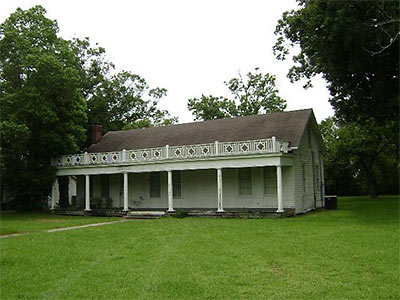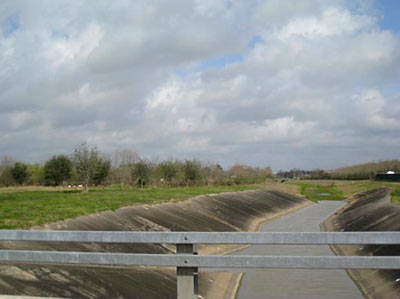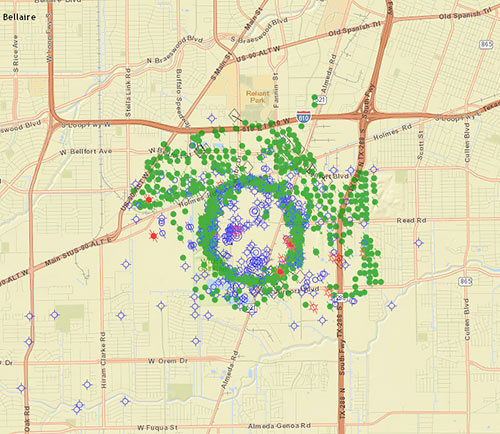
Right next door to the fairways of the Wildcat Golf Club, Fairway Energy Partners is moving forward with plans announced this summer to put nearly half a billion gallons of crude oil back into the ground, right in the center of the once-wild Pierce Junction oil field just south of the Inner Loop between S. Main St. and Highway 288. (The field, which a 1956 Time Magazine article called the site of “the biggest of all Gulf Coast oil booms,” still pumps out oil.) Fairway announced in November that they’ve picked engineers to help them retrofit 3 of the 8 man-made caverns dissolved into the Pierce Junction salt dome for crude storage. A dense ring of current and closed oil wells (mapped as green dots above) traces the uppermost reach of the migrant salt, buried approximately 950 feet below the surface and extending several miles deep to its source layer.


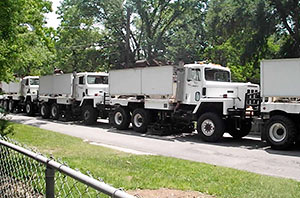 A neighborhood resident tells Swamplot what George Henderson, owner of Premier Geophysical Services, told the Park Place Civic Club last week about
A neighborhood resident tells Swamplot what George Henderson, owner of Premier Geophysical Services, told the Park Place Civic Club last week about  “As someone who used to work on seismic crews for years before moving into designing these subsurface programs, I can tell you all about these. Vibe machines shake the ground using varying frequencies, some you feel, many you can’t. Those waves penetrate the earth with some of the energy reflecting back to the surface when it hits a density change while some of the energy refracts deeper down. Geophones are placed in an array at set spacing surrounding the source (vibe) and ‘listen’ for these reflected waves to return and record the strength and timing of the returning wave.
So, as previously mentioned, this is an oil/gas survey not ‘minerals,’ although the subsurface rights are called ‘mineral rights.’
Mineral rights supercede those of surface rights. You absolutely can shoot seismic on someones land without their permission. It sets up bad rapport and ultimately it’s not the seismic company that makes that decision, it’s the oil/gas company that is hiring them to do so. It usually only has to happen on large tracts. Small ones, you can navigate around the refusal without compromising data integrity. Large tracts you have to get a TRO (temporary restraining order) and usually the local sheriff is brought in to ensure security. It was rare, but it did happen. Aside from bad blood between the landowner and the field crew, we would generally find some of our equipment damaged upon removal.” [
“As someone who used to work on seismic crews for years before moving into designing these subsurface programs, I can tell you all about these. Vibe machines shake the ground using varying frequencies, some you feel, many you can’t. Those waves penetrate the earth with some of the energy reflecting back to the surface when it hits a density change while some of the energy refracts deeper down. Geophones are placed in an array at set spacing surrounding the source (vibe) and ‘listen’ for these reflected waves to return and record the strength and timing of the returning wave.
So, as previously mentioned, this is an oil/gas survey not ‘minerals,’ although the subsurface rights are called ‘mineral rights.’
Mineral rights supercede those of surface rights. You absolutely can shoot seismic on someones land without their permission. It sets up bad rapport and ultimately it’s not the seismic company that makes that decision, it’s the oil/gas company that is hiring them to do so. It usually only has to happen on large tracts. Small ones, you can navigate around the refusal without compromising data integrity. Large tracts you have to get a TRO (temporary restraining order) and usually the local sheriff is brought in to ensure security. It was rare, but it did happen. Aside from bad blood between the landowner and the field crew, we would generally find some of our equipment damaged upon removal.” [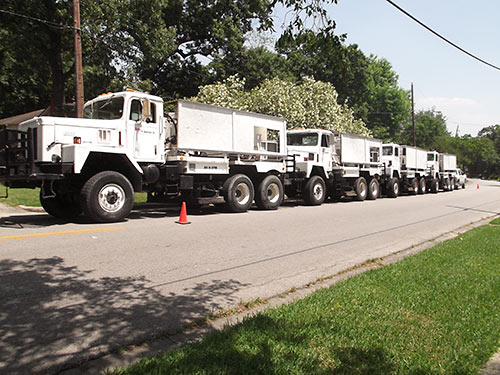
 League City’s city council voted last night to double the minimum distance oil and gas rigs must keep back from most buildings, including homes.
League City’s city council voted last night to double the minimum distance oil and gas rigs must keep back from most buildings, including homes. 